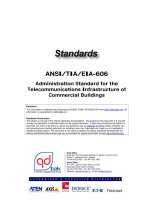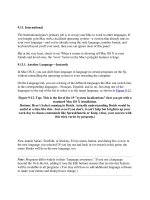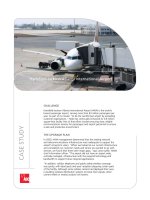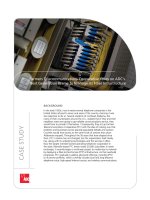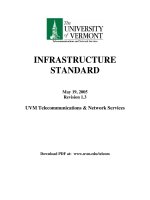International telecommunications conference 2017
Bạn đang xem bản rút gọn của tài liệu. Xem và tải ngay bản đầy đủ của tài liệu tại đây (11.28 MB, 301 trang )
Lecture Notes in Electrical Engineering 504
Ali Boyaci · Ali Riza Ekti
Muhammed Ali Aydin · Serhan Yarkan
Editors
International
Telecommunications
Conference
Proceedings of the ITelCon 2017,
Istanbul
Lecture Notes in Electrical Engineering
Volume 504
Board of Series editors
Leopoldo Angrisani, Napoli, Italy
Marco Arteaga, Coyoacán, México
Bijaya Ketan Panigrahi, New Delhi, India
Samarjit Chakraborty, München, Germany
Jiming Chen, Hangzhou, P.R. China
Shanben Chen, Shanghai, China
Tan Kay Chen, Singapore, Singapore
Rüdiger Dillmann, Karlsruhe, Germany
Haibin Duan, Beijing, China
Gianluigi Ferrari, Parma, Italy
Manuel Ferre, Madrid, Spain
Sandra Hirche, München, Germany
Faryar Jabbari, Irvine, USA
Limin Jia, Beijing, China
Janusz Kacprzyk, Warsaw, Poland
Alaa Khamis, New Cairo City, Egypt
Torsten Kroeger, Stanford, USA
Qilian Liang, Arlington, USA
Tan Cher Ming, Singapore, Singapore
Wolfgang Minker, Ulm, Germany
Pradeep Misra, Dayton, USA
Sebastian Möller, Berlin, Germany
Subhas Mukhopadhyay, Palmerston North, New Zealand
Cun-Zheng Ning, Tempe, USA
Toyoaki Nishida, Kyoto, Japan
Federica Pascucci, Roma, Italy
Yong Qin, Beijing, China
Gan Woon Seng, Singapore, Singapore
Germano Veiga, Porto, Portugal
Haitao Wu, Beijing, China
Junjie James Zhang, Charlotte, USA
** Indexing: The books of this series are submitted to ISI Proceedings, EI-Compendex,
SCOPUS, MetaPress, Springerlink **
Lecture Notes in Electrical Engineering (LNEE) is a book series which reports the latest research
and developments in Electrical Engineering, namely:
•
•
•
•
•
•
Communication, Networks, and Information Theory
Computer Engineering
Signal, Image, Speech and Information Processing
Circuits and Systems
Bioengineering
Engineering
The audience for the books in LNEE consists of advanced level students, researchers, and industry
professionals working at the forefront of their fields. Much like Springer’s other Lecture Notes
series, LNEE will be distributed through Springer’s print and electronic publishing channels.
For general information about this series, comments or suggestions, please use the contact
address under “service for this series”.
To submit a proposal or request further information, please contact the appropriate Springer
Publishing Editors:
Asia:
China, Jessie Guo, Assistant Editor () (Engineering)
India, Swati Meherishi, Senior Editor () (Engineering)
Japan, Takeyuki Yonezawa, Editorial Director ()
(Physical Sciences & Engineering)
South Korea, Smith (Ahram) Chae, Associate Editor ()
(Physical Sciences & Engineering)
Southeast Asia, Ramesh Premnath, Editor ()
(Electrical Engineering)
South Asia, Aninda Bose, Editor () (Electrical Engineering)
Europe:
Leontina Di Cecco, Editor ()
(Applied Sciences and Engineering; Bio-Inspired Robotics, Medical Robotics, Bioengineering;
Computational Methods & Models in Science, Medicine and Technology; Soft Computing;
Philosophy of Modern Science and Technologies; Mechanical Engineering; Ocean and Naval
Engineering; Water Management & Technology)
Christoph Baumann ()
(Heat and Mass Transfer, Signal Processing and Telecommunications, and Solid and Fluid
Mechanics, and Engineering Materials)
North America:
Michael Luby, Editor () (Mechanics; Materials)
More information about this series at />
Ali Boyaci Ali Riza Ekti
Muhammed Ali Aydin Serhan Yarkan
•
•
Editors
International
Telecommunications
Conference
Proceedings of the ITelCon 2017, Istanbul
123
Editors
Ali Boyaci
Department of Electrical-Electronics
Engineering
Istanbul Commerce University
Istanbul
Turkey
Ali Riza Ekti
Department of Information Technology
Balıkesir University
Balıkesir
Turkey
Muhammed Ali Aydin
Computer Engineering Department
Istanbul University
Istanbul
Turkey
Serhan Yarkan
Istanbul Commerce University
Istanbul
Turkey
ISSN 1876-1100
ISSN 1876-1119 (electronic)
Lecture Notes in Electrical Engineering
ISBN 978-981-13-0407-1
ISBN 978-981-13-0408-8 (eBook)
/>Library of Congress Control Number: 2018940400
© Springer Nature Singapore Pte Ltd. 2019
This work is subject to copyright. All rights are reserved by the Publisher, whether the whole or part
of the material is concerned, specifically the rights of translation, reprinting, reuse of illustrations,
recitation, broadcasting, reproduction on microfilms or in any other physical way, and transmission
or information storage and retrieval, electronic adaptation, computer software, or by similar or dissimilar
methodology now known or hereafter developed.
The use of general descriptive names, registered names, trademarks, service marks, etc. in this
publication does not imply, even in the absence of a specific statement, that such names are exempt from
the relevant protective laws and regulations and therefore free for general use.
The publisher, the authors and the editors are safe to assume that the advice and information in this
book are believed to be true and accurate at the date of publication. Neither the publisher nor the
authors or the editors give a warranty, express or implied, with respect to the material contained herein or
for any errors or omissions that may have been made. The publisher remains neutral with regard to
jurisdictional claims in published maps and institutional affiliations.
Cover design: INF Technology, Istanbul, Türkiye ()
LATEX editor: Serhan Yarkan
Printed on acid-free paper
This Springer imprint is published by the registered company Springer Nature Singapore Pte Ltd.
The registered company address is: 152 Beach Road, #21-01/04 Gateway East, Singapore 189721,
Singapore
Preface
ITelCon is an organization which is supported by both pioneering academicians
in their fields along with experts and professionals from industry. Under the
patronage of ITelCon organization, ITelCon 2017 is the First International
Telecommunications Conference, which was held in Teknopark Kurtköy, İstanbul,
Türkiye, on December 28–29, 2017. The conference was sponsored by several
institutions and companies in different categories. Istanbul Commerce University,
the foundation sponsor, hosted the conference in a great cooperation with Istanbul
Teknopark. Besides, Spark Measurement Technologies and Turkish Aerospace
Industries (TAI), Inc. supported ITelCon 2017 as platinum and gold sponsor,
respectively.
ITelCon 2017 came true with great efforts and collaboration of several committees. Honorary Chair, Nazım Ekren, Rector, along with İbrahim Baz, Vice
Rector, Istanbul Commerce University, supported the organizing committee with
immense enthusiasm. Executive Committee, Gülsüm Zeynep Gürkaş Aydın and
Serap Tepe, handled and run the conference seamlessly covering publicity, logistics
and announcements. Technical Program Chair, Özgür Can Turna, administered the
entire manuscript submission, delegation, and review processes in collaboration
with technical program committee consisting of more than 50 members representing 15 countries across the globe.
The conference program started with seven outstanding keynote speeches
delivered by prominent academicians and experts in the field. Opening speech was
given by Temel Kotil from TAI, which focused on concurrent and near-future
“research and development” trends in the industry. Second talk, which was given
by Tolga M. Duman from Bilkent University, was on the general research perspectives and opportunities for next-generation wireless communications. BİLGEM
Vice President, Ali Görçin, delivered a talk on behalf of BİLGEM Informatics and
Information Security Research Center, President, Hacı Ali Mantar, outlining the
comprehensive near-future research and development options and cutting-edge
research facilities and infrastructures at TÜBİTAK. Next, Erchin Serpedin from
Texas A&M University at College Station emphasized the importance of green
communications and networking in the upcoming era. In what follows, Hüseyin
v
vi
Preface
Arslan from University of South Florida underlined the physical layer security
concerns, possible solutions, and emerging security and privacy requirements for
5G and beyond. After that Tülay Yıldırım delivered an enlightening speech
regarding artificial intelligence, machine learning, and their use in the field of
telecommunications. Khalid A. Qaraqe from Texas A&M University at Qatar put
an emphasis on telehealth applications, how they would foster the daily life, and
very sensitive nature of the data to be carried over wireless networks in conjunction
with the security, privacy, and authenticity perspectives. Finally, Spark
Measurement Technologies, platinum sponsor of ITelCon 2017, introduced the
state-of-the-art measurement and instrumentation devices and software for 5G and
beyond.
On behalf of the ITelCon organizing committee, we would like to thank all the
people, companies, and organizations who contributed to making ITelCon 2017
successful. First and foremost, we acknowledge contributions of the authors who
considered submitting their valuable research outcomes to ITelCon 2017. Second,
ITelCon organizing committee appreciate the program committee members and the
reviewers across the globe whose sincere efforts in reviewing the manuscripts
improved both individual and overall scientific quality of the works and the conference, respectively. Special thanks are extended to the invited speakers, Temel
Kotil, Tolga M. Duman, Hacı Ali Mantar, Erchin Serpedin, Hüseyin Arslan, Tülay
Yıldırım, Khalid A. Qaraqe, and Çağan Irmak, for their sincere enthusiasm to take
an active part in ITelCon 2017. Under the patronage of Istanbul Chamber of
Commerce, we would like to thank Istanbul Commerce University, who made
ITelCon 2017 possible by providing all sorts of permissions, access, and man
power whenever needed along with Bilal Macit and his team from Istanbul
Teknopark who let organizing committee use their facilities throughout the conference. Last but not least, ITelCon 2017 would like to extend special thanks select
students of the EE Engineering Department at Istanbul Commerce University, for
their great assistance in running the workshop.
Istanbul, Turkey
Balıkesir, Turkey
Istanbul, Turkey
Istanbul, Turkey
Ali Boyaci
Ali Riza Ekti
Muhammed Ali Aydin
Serhan Yarkan
ITelCon 2017—Organizing Committee
Organization
Organizing Committee
General Chairs
Ali Boyaci, Istanbul Commerce University, Türkiye
Ali Riza Ekti, Balikesir University, Türkiye
Muhammed Ali Aydin, Istanbul University, Türkiye
Serhan Yarkan, Istanbul Commerce University, Türkiye
Executive Chairs
Gülsüm Zeynep Gürkaş Aydın, Istanbul University, Türkiye
Serap Tepe, Uskudar University, Türkiye
Program Committee
Program Chair
Özgür Can Turna, Istanbul University, Türkiye
Steering Committee
Erchin Serpedin, Texas A&M University at College Station, USA
Hüseyin Arslan, University of South Florida, USA
Khalid A. Qaraqe, Texas A&M University at Qatar Station, Qatar
Tülay Yıldırım, Yıldız Technical University, Türkiye
vii
viii
Local Committee
Gamze Kirman, Istanbul Commerce University, Türkiye
Sezer Can Tokgöz, Istanbul Commerce University, Türkiye
Özgür Alaca, Istanbul Commerce University, Türkiye
Sponsoring Institution
Istanbul Commerce University
Powered by
INF Technology, İstanbul, Türkiye
Organization
Contents
Part I
xG Networks
Performance Analysis of Relaying FSO System over M-Distributed
Turbulent Channel with Variable Gain AF Protocol . . . . . . . . . . . . . . .
V. K. Jagadeesh, Vineeth Palliyembil, Imran Shafique Ansari,
P. Muthuchidambaranathan and Khalid A. Qaraqe
Performance Analysis of Relay Assisted Mixed Dual-Hop RF-FSO
Systems with Pointing Errors . . . . . . . . . . . . . . . . . . . . . . . . . . . . . . . . .
V. K. Jagadeesh, Vineeth Palliyembil, Imran Shafique Ansari,
P. Muthuchidambaranathan and Khalid A. Qaraqe
Coverage Probability Analysis by Fractional Frequency Reuse
Scheme . . . . . . . . . . . . . . . . . . . . . . . . . . . . . . . . . . . . . . . . . . . . . . . . . .
Joydev Ghosh, Dushanta Nalin K. Jayakody, Marwa Qaraqe
and Theodoros A. Tsiftsis
Smart Raspberry Based GSM Gateway . . . . . . . . . . . . . . . . . . . . . . . . .
Belkacem Benadda, Karam Medjahdi and Bilal Beldjilali
IEEE 802.11s Mesh Network Analysis for Post Disaster
Communication . . . . . . . . . . . . . . . . . . . . . . . . . . . . . . . . . . . . . . . . . . .
Mehmet Ali Ertürk, Muhammed Ali Aydin, Luca Vollero
and Roberto Setola
Fuzzy Logic Approach for Layered Architecture Cognitive Radio
Systems . . . . . . . . . . . . . . . . . . . . . . . . . . . . . . . . . . . . . . . . . . . . . . . . .
Ali Riza Ekti
3
15
31
41
53
61
ix
x
Part II
Contents
Antennae and Propagation
A Model Selection Strategy of Gaussian Process Regression for
Modeling Inset-Fed Microstrip Patch Antenna . . . . . . . . . . . . . . . . . . . .
Karim Ferroudji, Abdelmaled Reddaf, Islem Bouchachi
and Boudjerda Mounir
A Comparison of Genetic Algorithm and Practical Swarm
Optimization for the Design of Waveguide Filters . . . . . . . . . . . . . . . . .
I. Bouchachi, K. Hamdi-Cherif, K. Ferroudji, M. Boudjreda, A. Reddaf
and M. L. Riabi
Part III
75
89
Localization
Deep Learning in Indoor Localization Using WiFi . . . . . . . . . . . . . . . . . 101
Zeynep Turgut, Serpil Üstebay, Gülsüm Zeynep Gürkaş Aydın
and Ahmet Sertbaş
LocSwayamwar: Finding a Suitable ML Algorithm for Wi-Fi
Fingerprinting Based Indoor Positioning System . . . . . . . . . . . . . . . . . . 111
Beenish Ayesha Akram, Ali Hammad Akbar, Bilal Wajid, Omair Shafiq
and Amna Zafar
AMNA: Probe Agent Based Inter-Process Dependency Model for
Wireless Sensor Network’s Fault DiAgnosis . . . . . . . . . . . . . . . . . . . . . . 125
Amna Zafar, Ali Hammad Akbar, Bilal Wajid, Beenish Ayesha Akram
and Talha Irfan
Position at Response: A Novel Highly Accurate and Low Cost Laser
Positioning System . . . . . . . . . . . . . . . . . . . . . . . . . . . . . . . . . . . . . . . . . 137
Turhan S. Dervish, Caleb G. Teague, Fangyao Liu, Adam Coffey,
Amit Kachroo, Sabit Ekin and Jerzy S. Krasinski
Part IV
Measurement
Jamming Resilience of LTE Networks: A Measurement Study . . . . . . . 151
Yağmur Coşkun, Mert Eygi, Gediz Sezgin and Güneş Karabulut Kurt
Impulsive Noise Modeling and Cancellation Strategies Over Power
Line Channels . . . . . . . . . . . . . . . . . . . . . . . . . . . . . . . . . . . . . . . . . . . . 163
Waled Gheth, Khaled M. Rabie and Bamidele Adebisi
An IEEE 802.11x Implementation for V2X Communications Towards
IoT and Big Data . . . . . . . . . . . . . . . . . . . . . . . . . . . . . . . . . . . . . . . . . . 177
Dilara Albayrak Serin, Ali Boyaci, Alper Özpınar and Serhan Yarkan
EMC Measurements in Indoor Power Line Communication
Environments . . . . . . . . . . . . . . . . . . . . . . . . . . . . . . . . . . . . . . . . . . . . . 189
Waled Gheth, Matjaz Rozman, Khaled M. Rabie and Bamidele Adebisi
Contents
Part V
xi
Security
Security Problems and Attacks on Smart Cars . . . . . . . . . . . . . . . . . . . 203
Ş. Okul, Muhammed Ali Aydin and Fatih Keleş
A Survey on White Box Cryptography Model for Mobile Payment
Systems . . . . . . . . . . . . . . . . . . . . . . . . . . . . . . . . . . . . . . . . . . . . . . . . . 215
Öznur Şengel, Muhammed Ali Aydin and Ahmet Sertbaş
User Association for Enhancing Physical Layer Security in
Heterogeneous Network . . . . . . . . . . . . . . . . . . . . . . . . . . . . . . . . . . . . . 227
Haji M. Furqan, Guftaar Ahmad Sardar Sidhu and Huseyin Arslan
Dynamic Feature Selection for Spam Detection in Twitter . . . . . . . . . . . 239
M. Salih Karakaşlı, Muhammed Ali Aydin, Serhan Yarkan and Ali Boyaci
Phishing Analysis of Websites Using Classification Techniques . . . . . . . 251
Doğukan Aksu, Zeynep Turgut, Serpil Üstebay and Muhammed Ali Aydin
Part VI
Signal Processing
Ear Biometric Recognition in Unconstrained Conditions . . . . . . . . . . . . 261
Amir Benzaoui and Abdelhani Boukrouche
Identification of Non-Conforming Cordless Phone Signals in Licensed
Bands . . . . . . . . . . . . . . . . . . . . . . . . . . . . . . . . . . . . . . . . . . . . . . . . . . . 271
Selen Geçgel, Mehmet Akif Durmaz, Hakan Alakoca,
Güneş Karabulut Kurt and Cem Ayyıldız
Fast Frequency Estimation of a Complex Sinusoidal When the Phase
Is Already Known . . . . . . . . . . . . . . . . . . . . . . . . . . . . . . . . . . . . . . . . . 281
Ahmet Serbes
Rapidly Varying Sparse Channel Tracking with Hybrid
Kalman-OMP Algorithm . . . . . . . . . . . . . . . . . . . . . . . . . . . . . . . . . . . . 289
Ayşe Betül Büyükşar, Habib Şenol, Serhat Erküçük and Hakan Ali Çırpan
Prediction of Physical Activity Times Using Deep
Learning Method . . . . . . . . . . . . . . . . . . . . . . . . . . . . . . . . . . . . . . . . . . 299
Gokhan Ozogur, Mehmet Ali Erturk and Muhammed Ali Aydin
Author Index . . . . . . . . . . . . . . . . . . . . . . . . . . . . . . . . . . . . . . . . . . . . . . . . 309
Part I
xG Networks
Performance Analysis of Relaying FSO
System over M-Distributed Turbulent
Channel with Variable Gain AF Protocol
V. K. Jagadeesh, Vineeth Palliyembil, Imran Shafique Ansari,
P. Muthuchidambaranathan and Khalid A. Qaraqe
Abstract In this work, the performance of an all optical relaying free space optical (FSO) system over Málaga (M)-distributed turbulent channel is analyzed with
variable gain amplify and forward (AF) protocol. For the relay system, the approximate cumulative distribution function (CDF) expression of the output signal to noise
ratio (SNR) is derived and corresponding outage probability, channel capacity and
asymptotic bit error rate (BER) are analyzed for different modulation schemes in the
presence of pointing errors.
Keywords Free space optics · Amplify and forward · Outage probability · Bit
error rate · Channel capacity · Pointing errors
1 Introduction
Free space optics (FSO) is an emerging technology that uses light emitting diodes
(LED) or laser diodes to transmit the data through wireless medium. The main advantages of FSO communication systems include large bandwidth with high data rate,
license free spectrum, easy installation, low power consumption, and greater security [1, 2]. Due to these features, FSO communication systems have found some
V. K. Jagadeesh (B)
Department of Electronics and Communication Engineering,
NMAMIT, Mangalore, India
e-mail:
V. Palliyembil · P. Muthuchidambaranathan
Department of Electronics and Communication Engineering,
National Institute of Technology, Tiruchirappalli, India
I. S. Ansari · K. A. Qaraqe
Department of Electrical and Computer Engineering,
Texas A & M University at Qatar (TAMUQ), Doha, Qatar
I. S. Ansari · K. A. Qaraqe
Education City, Ar-Rayyan, Qatar
© Springer Nature Singapore Pte Ltd. 2019
A. Boyaci et al. (eds.), International Telecommunications Conference,
Lecture Notes in Electrical Engineering 504,
/>
3
4
V. K. Jagadeesh et al.
applications in the area of indoor communications, underwater communications,
chip to chip communications, inter-satellite communications etc.
Even though, there are some challenges limiting the full potential of FSO communication systems. The atmospheric turbulence induced fading and pointing errors due
to misalignment are the main impairments affecting an optical signal when propagating through the turbulence channel and can degrade the performance of the system,
if the link range is more than 1 km [3–5]. Spatial diversity [6] and relay techniques
[7] are promising approaches to overcome these problems in FSO systems. The relay
techniques create a virtual multiple aperture system and realize the advantages of
multiple-input multiple-output (MIMO) techniques.
Relay based FSO systems is a well known technique that is utilized to improve the
performance of FSO systems by mitigating the limiting effects of scintillation and
misalignment fading [7]. It provides higher capacity with wider and more energy efficient coverage. The performance analysis of relay based FSO systems has been been
analyzed with amplify-and-forward (AF) and decode-and-forward (DF) relays over
different channel models [8, 9]. The AF relays have attracted a lot of research interest
due to less complexity. The variable gain AF relays use the channel state information
(CSI) of the preceding hop to control the relay gain; whereas, a fixed-gain AF relay
does not need the CSI. In [10, 11], the capacity performance of AF based FSO systems
have been discussed. The outage probability and the average bit error rate (BER) performance analysis of DF based FSO system over Gamma-Gamma channel analyzed
in [12]. The outage and error performances of bi-directional decode-XOR-forward
(DXF) relay FSO systems were analyzed over Málaga (M)-turbulence channel
in [13].
In this work, the performance of an all optical relaying FSO system over
M-distributed turbulent channel is analyzed with variable gain AF protocol. For the
relay system, the approximate cumulative distribution function (CDF) expression of
the output signal-to-noise ratio (SNR) is derived and the corresponding outage probability, channel capacity, and asymptotic BER are analyzed for different modulation
schemes.
2 System and Channel Model
A multi hop FSO system with variable AF gain relay under M-distribution [14] is
considered. The system model consists of a source (S), a destination (D), and a single
relay (R) node as shown in Fig. 1.
With the help of the relay, signals are transmitted from the transmitter to the target
user through the turbulence induced fading channels and are corrupted at the receiver
by the additive white Gaussian noise (AWGN) noise of zero mean and variance N0 .
The received signal at the relay R can be expressed as
ys,r = Is,r x + n s,r ,
(1)
Performance Analysis of Relaying FSO System over M-Distributed Turbulent …
5
Fig. 1 Relay assisted dual-hop transmission system
where x is the transmitted information by source, ys,r is the received signal at the
relay, Is,r represents the irradiance from source to the relay and n s,r , is the AWGN
at relay. The received signal at the destination is expressed as
yr,d = Ir,d G[1 + ηr,d (Is,r x + n s,r )] + n r,d ,
(2)
where yr,d is the received signal at the destination, Ir,d represents the irradiance from
relay to destination, G is the normalized amplifying gain, ηr,d is the electrical-tooptical conversion coefficient, and n r,d is the AWGN at the destination. Most of the
previous relaying FSO networks, G is assumed as a constant [15]. Here the value of
G is assumed as
G=
Pr
2
2
2
Is,r Ps,r ηr,d
+ N0
,
(3)
where Pr is the power received at the destination and Ps,r is the transmitted power
at the source. After removing the direct current (DC) component, the expression for
the received signal can be written as
yr,d = Ir,d Gηr,d (Is,r x + n s,r ) + n r,d .
(4)
The unconditional PDF for the M-distributed turbulence channel can be expressed
in terms of the SNR [16] as
f γ (γ) =
where
μ=
g2 A
4γ
β
bm G 3,0
1,3 B
m=1
γ
μ
g2 + 1
g 2 , α, m
,
g 2 (g 2 + 1)−2 (g 2 + 2)(ξg + )
γ,
¯
α−1 (α + 1)[2ξg (ξg + 2 ) + 2 (1 + 1/β)]
(5)
6
V. K. Jagadeesh et al.
is the electrical SNR of (5) and γ¯ is the average SNR,
B=
g 2 αβ(ξg + )
,
[(g 2 + 1)(ξg β + )]
α
A=
2α 2
1+ α2
ξg
Γ (α)
β+ α2
ξg β
ξg β +
k−1
k
β − 1 (ξg β + )1− 2
ak =
(k − 1)!
k−1
bm = ak
αβ
ξg β +
ξg
,
α
β
k
2
,
− α+k
2
g is the pointing error parameter. α is a positive parameter related to the effective
number of large-scale cells of the scattering process, and β represents the amount
of fading parameter. ξg is denoted as ξg = 2b0 (1 − ρ). b0 is the average power of
the total scatter components and ρ is the amount of scattering power coupled [17].
represents the average power from the coherent contributions [14].
When g 2 (ξg + )/(g 2 + 1) = 1, this PDF given in (5) comes in agreement with
[18, Eq. (19)].
Utilizing (3) and (4), the end-to-end SNR can be obtained and is tightly upper
bounded at high SNR values as
γeq =
where γs,r =
2 2
Ps,r
Is,r
N0
γs,r γr,d
γs,r γr,d
≈
,
γs,r + γr,d + 1
γs,r + γr,d
and γr,d =
(6)
2
2
ηr,d
Ir,d
.
N0
3 Cumulative Distribution Function
When using the upper bound of γeq , it is well known that the CDF of γeq is given as
Fγeq (γ) = 1 − (1 − Fγs,r (γ))(1 − Fγr,d (γ))
= Fγs,r (γ) + Fγr,d (γ) − Fγs,r (γ)Fγr,d (γ),
(7)
where Fγs,r (γ) and Fγr,d (γ) are the CDF of γs,r and γr,d , respectively. From Eq. (5),
the CDF of γs,r is obtained as
Performance Analysis of Relaying FSO System over M-Distributed Turbulent …
2
As,r
gs,r
Fγs,r (γ) =
8π
×G 6,1
3,7
g2
where k1 = 2s,r ,
for Fγr,d (γ) as
2
gs,r
+1 αs,r
, 2
2
7
βs,r
bm s,r 2αs,r +m s,r −1
m s,r =1
2
γ
Bs,r
16μs,r
1,
2
2
gs,r
+1 gs,r
+2
, 2
2
k1
,
(8)
, αs,r2+1 , m2s,r , m s,r2+1 , 0. A similar expression is obtained
Fγr,d (γ) =
2
gr,d
Ar,d
8π
×G 6,1
3,7
βr,d
bm r,d 2αr,d +m 2 −1
m r,d =1
2
Br,d
γ
1,
16μr,d
2
2
gr,d
+1 gr,d
+2
, 2
2
k2
,
(9)
where the parameters Ar,d , αr,d , m r,d and βr,d have the same definitions as previously mentioned, but they are related to the link condition between the relay and the
destination.
4 System Performance Analysis
In this section, the performance of the relay based FSO system over M-distributed
turbulence conditions is analyzed. More specifically, the expressions for the asymptotic outage probability and BER are derived.
4.1 Outage Probability
Outage probability is an important performance metric in communication system
and is defined as the probability that the instantaneous SNR γeq falls below a given
threshold value γth . From this definition, the outage probability is given as
Pout = Feq (γth ).
(10)
For high SNR regime, the last term in Eq. (7) is neglected and the accurate expression
for the outage probability is given as
Pout ≈ Fs,r (γth ) + Fr,d (γth ).
(11)
8
V. K. Jagadeesh et al.
Table 1 Parameters (p and q) for various binary modulation techniques
Type of modulation
p
Coherent binary frequency shift keying (CBFSK)
Non-coherent binary frequency shift keying (NBFSK)
Coherent binary phase shift keying (CBPSK)
Differential binary phase shift keying (DBPSK)
0.5
1
0.5
1
q
0.5
0.5
1
1
4.2 BER Analysis
The average BER of the proposed system can be expressed in terms of the CDF as
[19]
Pe =
qp
2Γ ( p)
∞
exp(−qγ)γ p−1 Fγ (γ)dγ.
(12)
0
In the above equation p and q are the BER parameters corresponding to the four
modulation schemes as given in Table 1 [15].
On substituting Eq. (7) into (12) and utilizing [20, Eq. (7.813.1)], the average BER
performance of a relaying FSO network for different modulation schemes, at high
SNR regime, can be derived as
Pe = Ps,r + Pr,d ,
(13)
where
Ps,r =
2
As,r
gs,r
16πΓ p
×G 6,2
4,7
g 2 +1
g 2 +2
βs,r
bm s,r 2αs,r +k1 −1
m s,r =1
2
Bs,r
16qμs,r
where k3 = 1 − p, s,r2 , s,r2 and k4 =
has a similar expression as Ps,r .
2
gs,r
2
,
k3
k4
,
(14)
2
gs,r
+1 αs,r
, 2
2
, αs,r2+1 , m2s,r , m s,r2+1 , 0. Pr,d
4.3 Channel Capacity
The ergodic channel capacity can be defined as C = E[log2 (1 + cγ)], where c =
1for heterodyne detection and c = e/2π for IM/DD [21, Eq. (7.43)]. This can be
represented as
Performance Analysis of Relaying FSO System over M-Distributed Turbulent …
∞
C=
log2 (1 + e/2πγ) f γ (γ)dγ.
9
(15)
0
Now substituting Eq. (5) into (15) and utilizing [22], the ergodic channel capacity
of a relaying FSO network, at high SNR regime, is obtained as
C = Cs,r + Cr,d ,
(16)
where
Cs,r =
2
As,r
gs,r
16πln2
×G 7,1
3,7
where k5 =
2
gs,r
2
βs,r
bm s,r 2αs,r +k1
m s,r =1
2
π
Bs,r
8eμs,r
g 2 +2
0, 1, s,r2
k5
,
(17)
, α2s,r , αs,r2+1 , m2s,r , m s,r2+1 , 0, 0. Cr,d has a similar expression as Cs,r .
5 Results and Discussion
In this section, the analysis is conducted with some numerical results for the channel
model under consideration with variable gain AF relay. In all cases, the following
parameters are considered in the numerical results: the transmitted power is normalized as + 2b0 = 1, the channel parameters α1 = 10, α2 = 4, β1 = 5, β1 = 2,
and γth = 6 dB. The average and electrical SNRs of both the links are assumed to
be equal. The performance of the system is analyzed with outage probability, the
channel capacity, and the asymptotic BER of coherent binary frequency shift keying
(CBFSK), non-coherent binary frequency shift keying (NBFSK), coherent binary
phase shift keying (CBPSK), differential binary phase shift keying (DBPSK) modulation schemes.
In Fig. 2, the outage performance is analyzed for different values of ρ and g. From
the figure, it is observed that increasing ρ can improve the outage performance of
the system. It is also observed that the outage performance is also improved with
increase in g parameter because the definition of g is the ration between equivalent
beam radius at the receiver and the pointing error displacement standard deviation
at the receiver.
In Figs. 3 and 4, the asymptotic BER of relay based FSO system is analyzed
under the effect of pointing errors with turbulence for different modulation schemes.
Figure 3 shows the asymptotic BER performance of the system with ρ = 0 and Fig. 4
shows the same analysis for ρ = 1. From the figures it is observed that the CBFSK
modulation outperforms NBFSK because it is the most power-efficient modulation schemes. Coherent modulation schemes perform better than their non coherent
10
V. K. Jagadeesh et al.
Fig. 2 Outage performance of a relaying FSO network with pointing errors
Fig. 3 BER performance of a relaying FSO network for ρ = 0 with pointing errors
scheme. It is also observed that the performance for ρ = 1 is much better. And it is
also observed that as the effect of pointing errors (as the value of g increases, the
effect of pointing error decreases) increases, the BER deteriorates and vice versa.
In Fig. 5, the ergodic channel capacity of the system is analyzed under the combined effect of atmospheric turbulence and pointing errors for different values of
Performance Analysis of Relaying FSO System over M-Distributed Turbulent …
11
Fig. 4 BER performance of a relaying FSO network for ρ = 1 with pointing errors
Fig. 5 Channel capacity of a relaying FSO network with pointing errors
ρ = 0, 0.5, 0.75, 1 and g = 0.5, 1.2. The cases of ρ = 0 and ρ = 1 correspond to the
special cases of the K and the Gamma-Gamma distributions, respectively. From the
figure, it is observed that the channel capacity improves with g parameter. The better
channel capacity is obtained for g = ∞ (zero pointing error). Also, it is observed that
the better channel capacity is obtained for ρ = 1 because the turbulence intensity, σ 2I
of the FSO link, decreases with increase in ρ.
12
V. K. Jagadeesh et al.
6 Conclusion
The outage and BER analysis of dual-hop FSO system using a variable gain AF
protocol are analyzed in the presence of M-distributed atmospheric turbulence and
misalignment errors. The closed form expressions for the outage probability and the
average BER of different modulation schemes are derived. It is analyzed that with
increase in pointing errors, both the outage probability and the BER increase and
thus degrade the system performance significantly.
Acknowledgements This publication was made possible by NPRP grant # [NPRP8-648-2-273]
from the Qatar National Research Fund (QNRF) (a member of Qatar Foundation (QF)). The statements made herein are solely the responsibility of the authors
References
1. Majumdar AK, Ricklin JC (2010) Free-space laser communications: principles and advances.
Springer Science & Business Media, Berlin
2. Kedar D, Arnon S (2004) Urban optical wireless communication networks: the main challenges
and possible solutions. IEEE Commun Mag 42(5):S2–S7
3. Zhu X, Kahn JM (2002) Free-space optical communication through atmospheric turbulence
channels. IEEE Trans Commun 50(8):1293–1300
4. Arnon S (2003) Effects of atmospheric turbulence and building sway on optical wirelesscommunication systems. Opt Lett 28(2):129–131
5. Borah DK, Voelz DG (2009) Pointing error effects on free-space optical communication links
in the presence of atmospheric turbulence. J Lightwave Technol 27(18):3965–3973
6. Navidpour SM, Uysal M, Kavehrad M (2007) BER performance of free-space optical transmission with spatial diversity. IEEE Trans Wirel Commun 6(8)
7. Safari M, Uysal M (2008) Relay-assisted free-space optical communication. IEEE Trans Wirel
Commun 7(12):5441–5449
8. Karimi M, Nasiri-Kenari M (2010) Outage analysis of relay-assisted free-space optical communications. IET Commun 4(12):1423–1432
9. Bhatnagar MR (2012) Average BER analysis of differential modulation in DF cooperative communication system over gamma-gamma fading FSO links. IEEE Commun Lett 16(8):1228–
1231
10. Peppas KP, Stassinakis AN, Nistazakis HE, Tombras GS (2013) Capacity analysis of dual
amplify-and-forward relayed free-space optical communication systems over turbulence channels with pointing errors. J Opt Commun Netw 5(9):1032–1042
11. Aggarwal M, Garg P, Puri P (2015) Exact capacity of amplify-and-forward relayed optical
wireless communication systems. IEEE Photonics Technol Lett 27(8):903–906
12. Bhatnagar MR (2012) Performance analysis of decode-and-forward relaying in gamma-gamma
fading channels. IEEE Photonics Technol Lett 24(7):545–547
13. Sharma PK, Garg P (2014) Bi-directional decode-XOR-forward relaying overM-distributed
free space optical links. IEEE Photonics Technol Lett 26(19):1916–1919
14. Jurado-Navas A, Garrido-Balsells JM, Paris JF, Puerta-Notario A (2011) A unifying statistical
model for atmospheric optical scintillation. arXiv:1102.1915
15. Ansari IS, Yilmaz F, Alouini MS (2013) Impact of pointing errors on the performance of mixed
RF/FSO dual-hop transmission systems. IEEE Wirel Commun Lett 2(3):351–354
16. Ansari IS, Yilmaz F, Alouini MS (2016) Performance analysis of free-space optical links over
Málaga (M) turbulence channels with pointing errors. IEEE Trans Wirel Commun 15(1):91–
102
Performance Analysis of Relaying FSO System over M-Distributed Turbulent …
13
17. Jurado-Navas A, Balsells JMG, Paris JF, Castillo-Vzquez M, Puerta-Notario A (2011) General
analytical expressions for the bit error rate of atmospheric optical communication systems. Opt
Lett 36(20):4095–4097
18. Samimi H, Uysal M (2013) End-to-end performance of mixed RF/FSO transmission systems.
J Opt Commun Netw 5(11):1139–1144
19. Ansari IS, Al-Ahmadi S, Yilmaz F, Alouini MS, Yanikomeroglu H (2011) A new formula
for the BER of binary modulations with dual-branch selection over generalized-K composite
fading channels. IEEE Trans Commun 59(10):2654–2658
20. Gradshteyn IS, Ryzhik IM (2000) Table of integrals, series, and products. Academic Press, San
Diego
21. Arnon S, Barry J, Karagiannidis G (eds) (2012) Advanced optical wireless communication
systems. Cambridge University Press, Cambridge
22. Adamchik VS, Marichev OI (1990) The algorithm for calculating integrals of hypergeometric type functions and its realization in reduce system. In: Proceedings of the international
symposium on Symbolic and algebraic computation, ACM, pp 212–224
Performance Analysis of Relay Assisted
Mixed Dual-Hop RF-FSO Systems
with Pointing Errors
V. K. Jagadeesh, Vineeth Palliyembil, Imran Shafique Ansari,
P. Muthuchidambaranathan and Khalid A. Qaraqe
Abstract In this work, a fixed-gain amplify-and-forward (AF)- relay assisted dualhop RF-FSO communication system with pointing errors is analyzed by considering
Rayleigh/Málaga (M)- distributed turbulence channel. For this mixed RF-FSO cooperative system, a novel closed form analytical expressions are obtained for moment
generating function (MGF), outage probability and average bit error rate (BER) for
various binary and M-ary modulation techniques. Additionally, by using the asymptotic expansion of the Meijer’s G function at the high SNR regime, we derive new
asymptotic expressions for the CDF, outage probability, and the average BER in
terms of simple elementary functions.
Keywords RF-FSO · Rayleigh fading · Málaga distribution ·
Amplify-and-forward relay · Bit error rate · Outage probability
1 Introduction
Wireless communication is so pervasive that it has even changed the way we live and
radio frequency (RF) spectrum scarcity has become one of the major concerns in the
area of wireless communications. Optical wireless communication (OWC) has been
emerging as a promising alternative due to its advantages including higher bandwidth
V. K. Jagadeesh (B)
Department of Electronics and Communication Engineering, NMAMIT, Mangalore, India
e-mail:
V. Palliyembil · P. Muthuchidambaranathan
Department of Electronics and Communication Engineering,
National Institute of Technology, Tiruchirappalli, India
I. S. Ansari · K. A. Qaraqe
Department of Electrical and Computer Engineering, Texas A & M University at Qatar
(TAMUQ), Doha, Qatar
I. S. Ansari · K. A. Qaraqe
Education City, Ar-Rayyan, Qatar
© Springer Nature Singapore Pte Ltd. 2019
A. Boyaci et al. (eds.), International Telecommunications Conference,
Lecture Notes in Electrical Engineering 504,
/>
15

